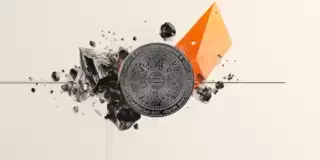 |
|
 |
|
 |
|
 |
|
 |
|
 |
|
 |
|
 |
|
 |
|
 |
|
 |
|
 |
|
 |
|
 |
|
 |
|
Cryptocurrency News Articles
Coinbase Has Disclosed That It's the Largest Node Operator on Ethereum, With 120,000 Validators
Mar 21, 2025 at 04:01 am
In a new report, the exchange claimed it has 3.84 million ETH staked through its validators as of March 4, representing 11.42% of the total staked Ether.

Coinbase has disclosed that it is the largest node operator on Ethereum, with 120,000 validators and 3.84 million ETH staked through its validators as of March 4, representing 11.42% of the total staked Ether.
The exchange claims to have an uptime of 99.75% in February 2025, which means that its validators were online and operational for 99.75% of the month.
The company’s goal is to maintain an uptime of at least 99% for its validators, which aligns with the minimum uptime requirement set by Ethereum. However, Coinbase’s validators typically achieve an uptime of 99.9%, demonstrating its commitment to seamless operation and minimal downtime.
However, Coinbase keeps the uptime below the peak of 99.9% for security reasons. By doing so, the exchange claims that it has avoided security concerns such as double signing.
Since its inception, Coinbase has never experienced double signing or slashing. Slashing is a penalty in which Ethereum validators lose a percentage of their stake for committing infractions that affect network security. The slashed tokens usually go into Ethereum security.
It said: “Targeting 99.9% requires security tradeoffs that can increase the risk of double signing resulting in slashing penalties. At Coinbase, high uptimes are important but we always prioritize the security of our customers’ assets over liveness.”
Meanwhile, the exchange noted that the higher-than-expected uptime in February is due to the upgrade in its architecture, which allows validators to keep operating even when maintenance is carried out on the beacon node.
Beyond the high uptime, the report also shows a relatively high participation rate of 99.75%. This metric captures the number of validators performing their consensus duty and exceeds the network average of 99.52%.
Coinbase stake attracts crypto community attention
With Coinbase disclosing its stake in Ethereum, concerns about centralization on Ethereum have resurfaced. Although the exchange’s 11.42% stake is smaller than Lido’s, Coinbase is the biggest node operator, while Lido is a collective with smaller stakes for each node operator.
Some users, including Daily Gwei founder Anthony Sassano, have praised Coinbase’s transparency, while others note that it shows institutional commitment to ETH. However, most users focus on the size of the stake, which they believe makes Ethereum less censorship-resistant.
However, Coinbase addresses these concerns in its report, noting the diversity of its validators as proof that the network is still decentralized. The exchange claimed to have two consensus clients, two execution clients, and six relay clients.
The consensus clients are Lighthouse and Prysm, who account for 63.8% of the total network distribution. For the execution clients, Geth and Nethermind account for 79 of network distribution. This suggests that the Coinbase consensus and execution clients dominate the Ethereum network, likely because other validators also use them.
Nevertheless, the exchange noted its relay diversity, with six unique MEV relays, four of which are non-censoring, which has helped to reduce the risk of centralization while also avoiding a single point of failure and minimizing downtime. It acknowledged the risk of diversification and said there are plans to improve its client diversity.
It said: “We are currently evaluating the production readiness of two more implementations and plan to continue expanding our client diversity.”
One area where the exchange appears to have more decentralization is the geographical location of its validators. Coinbase validators operate in five countries, including Singapore, Japan, Ireland, Hong Kong, and Germany, and there are also two cloud providers, Amazon Web Services and Google Cloud Platform.
Disclaimer:info@kdj.com
The information provided is not trading advice. kdj.com does not assume any responsibility for any investments made based on the information provided in this article. Cryptocurrencies are highly volatile and it is highly recommended that you invest with caution after thorough research!
If you believe that the content used on this website infringes your copyright, please contact us immediately (info@kdj.com) and we will delete it promptly.
-

- Solana Labs, Consensys, and Uniswap Donate to Donald Trump's Inauguration Fund Preceding SEC Enforcement Decisions
- Apr 22, 2025 at 12:05 pm
- United States (US) Securities and Exchange Commission (SEC) enforcement decisions follow $239 million in Donald Trump's inaugural donations, including funds from top crypto firms Solana, Consensys, and Uniswap.
-

-

- Bitcoin's impressive market growth is driving increased attention to new crypto listings despite recent volatility.
- Apr 22, 2025 at 12:00 pm
- Cortex Protocol ($CX) celebrates Bitcoin's bullish future, aligning community hype with a $250,000 target narrative. A presale nearing $5 million shows growing support for meme-powered optimism and long-term Bitcoin enthusiasm.
-

- The Pi (π) Coin price has plummeted 80%, wiping out $940 million in market capitalization
- Apr 22, 2025 at 12:00 pm
- The Pi coin price has experienced a sharp decline, tumbling nearly 80% from its February peak. This steep drop wiped out approximately $9.4 billion in market capitalization, shrinking its valuation from $13.8 billion to just $4.4 billion.
-

-

-

-

-



























































